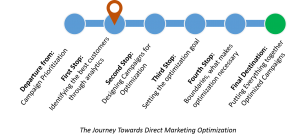Welcome back to our journey toward marketing optimization! If you missed the introduction, I previously explained the concept of direct marketing optimization in my last post, "The journey toward direct marketing optimization.” From that departure point, the topics in this post will take us to the first stop in the journey where we'll explore how to optimize the target selection.
I'll start by explaining how to understand the value of each customer for each offer using basic and advanced analytics. Even if you are a campaign manager and already familiar with this approach, let's quickly review it because it's vital in order to feed the optimization algorithm with appropriate data.
Differentiating customers through analytics
When selecting targets for campaigns, we need to know which customers are more suitable for each of the campaigns. Think of "suitability" as the probability of the customer to accept the offer. This probability will be more or less accurate, depending on the analytical methods we use.
In order to explain this, I will use the same example I used before. We have a scenario with two offers and two clients where:
Profit = probability of response * offer value
A customer can be more suitable for a campaign because he/she has a higher propensity to accept, or because the value it can generate is greater. The value we need to assign to a customer depends on the optimization objective we set. We'll will cover that idea in a future post, and for now let's focus on the probability of response.
Predictive Analytics
The ideal situation would be to have propensity scores for each of the offers that a customer is eligible for, as this would help you improve how you select your targets. In that regard, it's not only about calculating the scores, but also understanding how these scores were calculated. It's not the same to calculate the probability to accept an offer as it is to calculate the probability of buying a certain product. The modelling approach is different and the results might be different as well. Let me explain it with an example:
In order to improve targeting, a Telecommunications company wants to know the probability of a customer to buy a new Smartphone next month. To calculate this, they take the last month's campaign data where they offered the new Smartphone at a special price. With the past targets, their descriptive data and the responses, they run a data mining algorithm and build a predictive model. This predictive model allows them to score the new targets for the new offer. This approach is called response modeling.
Another way of calculating the propensity of a customer to buy a new Smartphone without campaign response data could be to identify customers that changed their mobile model from one month to the following and those who did not. This flag will be similar to the response flag we could have from a campaign. With this information and the customers’ descriptive data, they could run a data mining algorithm and build a predictive model. New targets then would be scored with the model.
The key is to understand if conditions were similar from one period to another. Predictive models are based on historical data. If the company offers the new Smartphone at very different prices each month, then predictive scores might not be that precise. For instance, a customer probably would be more willing to buy the last model at half-price this month, than only getting a 10 per cent discount last month. Analysts should inform campaign managers about the approaches followed in order to let campaign managers make better target selections. These considerations are also very important in the optimization process.
Descriptive Analytics
Predictive modeling is not the only way to categorize customers through analytics. Another valid technique is to use past response rates, without building predictive models.
Using the same example as above, we could calculate the response rate by segments or another descriptive variable (data plan, account aging, etc.) and use this information to assign “probabilities” to the new targets. This could be done with all the offers and we could assign a value to each of the offers we want to optimize.
Although this technique might not be the most precise one, in many situations it is far better than existing prioritization methods and much easier to achieve.
Choose Carefully
Whichever analytical method is used, the important thing is to be able to differentiate among customer sub-sets with meaningful variables that you choose carefully. Without that valid differentiation, all customers will essentially be the same in terms of probabilities and value. The end result would be an optimization algorithm with limited information to pick one customer over the other for each of the campaigns.
Our next stop in this journey toward marketing optimization will be to explore designing campaigns for optimization. Thanks for joining us on this journey! Please stay on board for the whole trip - I promise it will be worth it!



2 Comments
Pingback: Optimization step 3: setting the goal - Customer Analytics
Pingback: The analytics of customer intelligence, and why it matters